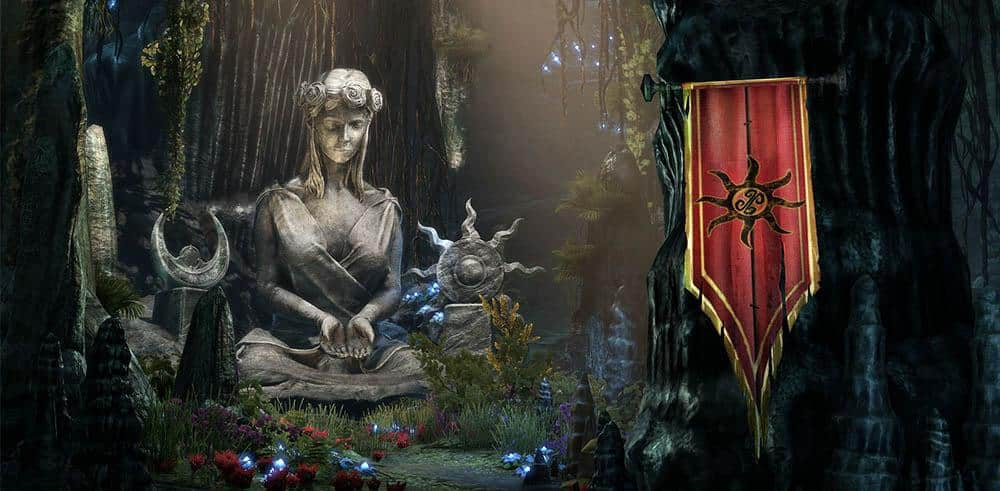
Light and shadow are powerful tools
Use the Environment to Set the Scene
Cullen: A good question to ask yourself is “How do I want people to feel when they walk into this space?” Jagged shapes and broken objects might tend to make people feel anxious, while smooth shapes and flowers can lend a sense of serenity. For a shine to Sheogorath, you might want an environment that feels unbalanced or chaotic, while a shrine to Clavicus Vile might be inviting at first glance but use subtle danger-signaling elements to suggest it’s a little too good to be true.
Kimberly: Ideally, worldbuilders want an environment that draws the player into the story immediately. Darkness is optimal for those with an affinity for Nocturnal’s realm, but if we can’t control the environment and summon night at all times, we’ll utilize what we do have to set the scene. For example, you could choose a dark interior, such as a cave or dimly lit room, and add in some heavy fog reminiscent of Evergloam’s gloom along with decor in vivid shades of blue and violet. Add in a few ghostly lights and you’re ready to slink into the shadows between.
Tell a Story
Kimberly: A great way to tell a story is to ask a lot of questions and then visually portray the answers. For instance, I might place a skeleton in the game and want to explain how they perished without using words. What was this individual doing here? What led to their demise? Can I visually show this somehow? Small props can go a long way, perhaps suggesting that this adventurer trusted the wrong Daedric Prince.
Cullen: Yeah! A good trick can be to start with a relatively obvious question and answer, to help get people in the right frame of mind, and then work your way up to more subtle connections. Building on Kim’s example, at first you could show two skeletons near a gruesome kitchen: one laid out as if trying to flee with a satchel of poisons, and the other slumped against a nearby wall, holding a knife. If you can make it clear that the first skeleton was murdered, you can get people to realize that you are telling a story, and not just placing skeletons for their spooky ambiance. Then later on, you can show them what that satchel of poison was used for …
Use Thematic Elements and Maintain Focus
Cullen: With shrines, it’s important to keep the focus on the shrine itself, and make sure that everything else in the scene is supporting it instead of distracting from it. If you have a great idea for something outside that’s a thematic fit, but would overshadow your shrine, try adding it later on the visitor’s journey. That said, there are no real rules when it comes to worshiping Daedra, so follow your heart!
Kimberly: I like to keep in mind the thematic elements associated with each Daedric Prince and incorporate those attributes when possible. For example, fire and brimstone will complement dark pointy furnishings perfectly for worshipers of Mehrunes Dagon while a tangle of foliage haunted by the presence of vile creatures may appeal more to Hircine’s followers.
